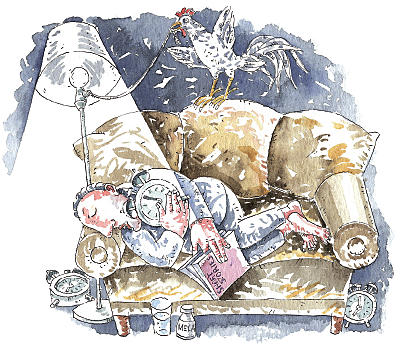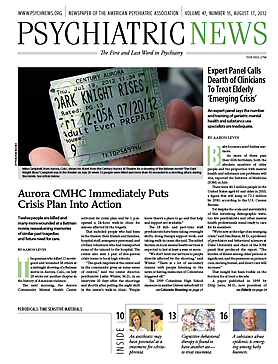Adjusting cognitive-behavioral therapy for insomnia (CBTI) to a patient’s circadian rhythms may improve both sleep and coexisting psychiatric symptoms.
People with major depressive disorder, anxiety, or bipolar disorder, in particular, often benefit from this approach, according to speakers at the annual meeting of the Associated Professional Sleep Societies in Boston in June (see Consider Daily Rhythms in Children Too below).
CBTI aims to replace beliefs and behaviors that undermine sleep with concepts and strategies that promote good sleep, said Rachel Manber, Ph.D., a professor of psychiatry and behavioral sciences at Stanford University School of Medicine.
The benefits of CBTI extend beyond insomnia and include improvements in nonsleep outcomes, such as overall well-being and depressive symptom severity, including suicidal ideation, among patients with baseline elevations, Manber and colleagues reported in the Journal of Clinical Sleep Medicine in June 2011.
CBTI practitioners advise a fixed bedtime and rise time for people who have persistent trouble falling and staying asleep, awaken too early, or feel unrefreshed by sleep. Following a regular schedule and restricting time in bed help consolidate sleep.
Some people with depressive disorders, Manber said, have diurnal variations in mood that hinder compliance with the prescribed schedule.
Those who feel better in the evening may delay going to bed. They then may get up too late to get to school or work on time.
Those whose mood is worse in the evening may have trouble postponing sleep until the designated bedtime. They may go to bed early and then awaken earlier than desired.
Those who feel worse in the morning may resist getting out of bed at their designated rise time. Getting up late also pushes circadian rhythms later, further hampering efforts to stick to a fixed bedtime and wake time.
People with delaying tendencies need ample time to unwind before bedtime, Manber said. Some like to read before going to sleep, but have trouble putting the book down. She suggested that they read only short works at bedtime.
People who awaken too early often experience sleep inertia. Feeling foggy or draggy for an hour or more after awakening may lower their motivation to get going. Advise them to plan ahead, she suggested, to meet a friend in the morning to exercise or have coffee.
Emphasize the importance of getting out of bed at a fixed time, she said, both during treatment and to prevent relapse. Some people need multiple alarms staggered temporally as well as spatially to rouse them. A new type of alarm clock jumps off a nightstand and spins, beeping until silenced.
Getting or avoiding bright-light exposure at specific times may reduce insomnia, according to Leon Lack, Ph.D., a professor of psychology at Flinders University in Adelaide, South Australia. Light traveling through the eyes to the brain sets the body’s biological clock.
Evening bright-light exposure can help people who complain that they fall asleep and awaken too early to stay up later and sleep later in the morning, he said, and sleep longer overall.
Exposure to bright light soon after awakening in the morning advances rhythms, helping people with sleeponset insomnia fall asleep earlier. Avoiding bright light near bedtime helps foster sleep.
Light technology has progressed, Lack said, from stationary light boxes to portable devices such as light visors and eyeglasses equipped with light emitting diodes.
Use of exogenous melatonin also can shift rhythms, said James Wyatt, Ph.D., an associate professor of behavioral sciences at Rush Medical College. Melatonin secretion usually starts about two hours before sleep onset. People with delayed sleep onset who take 0.3 mg melatonin five to seven hours before their usual bedtime may be able to fall asleep earlier. They should anticipate sleepiness, Wyatt said, and avoid driving. He also recommended dimming lights and reducing brightness on television and computer monitors about two hours before bedtime.
People with bipolar disorder often report variability in bedtime and wake times over a single week of nearly three hours, said Allison Harvey, Ph.D., a professor of clinical psychology at the University of California, Berkeley. Sleep loss is highly correlated with daily mood disturbances in this population, she said, and may trigger mania.
Some 47 percent of adults with bipolar disorder in her ongoing study, funded by the National Institute of Mental Health, are unemployed. “It’s hard to address sleep issues in people who don’t have to get up at a specific time to get to work and may not have much to look forward to each day,” Harvey noted. Many also have comorbid anxiety.
Nonetheless, she said, an eight-week course of CBTI has helped many of the 48 study participants adopt better sleep-management tactics, regularize bedtime and wake time, and improve sleep and mood.
“We hope,” she added, “that improved sleep will help prevent recurrences of their bipolar disorder.”

Consider Daily Rhythms in Children Too
Circadian factors may contribute to sleep and behavioral disturbances in children as well as adults, said Kelly Byars, Psy.D., an associate professor of clinical pediatrics at the University of Cincinnati College of Medicine.
Some children require extended rocking, feeding, or soothing to fall asleep. Others stall at bedtime or refuse to go to bed at an appropriate time. Night waking may require prolonged parental intervention.
Few families that come to Byars’ clinic have tried delaying bedtime, he said. Parents typically assume it is better to put a child to bed earlier. He and his colleagues find that a “faded bedtime” eases childhood insomnia. They set bedtime to coincide with the child’s current sleep-onset time and help parents devise a pleasant bedtime routine.
They encourage parents to monitor crying but not respond to it immediately, aiming to reduce such behavior by not reinforcing it. If parents consistently wait a few minutes before taking a crying child out of bed, Byars said, the child usually falls asleep faster soon. Bedtime then can move earlier.

